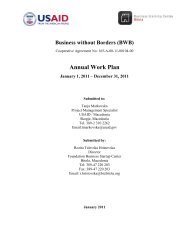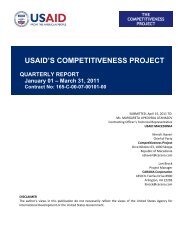FINAL REPORT - USAID Macedonia
FINAL REPORT - USAID Macedonia
FINAL REPORT - USAID Macedonia
You also want an ePaper? Increase the reach of your titles
YUMPU automatically turns print PDFs into web optimized ePapers that Google loves.
and industry associations. These market linkage activities gained momentum in FY2010, with a growing number<br />
of requests for quotes (RFQs), sampling, trial orders and production through the end of the project.<br />
Integration of Vertical and Horizontal Activities for Seamless Implementation<br />
MCP intertwined vertical and horizontal components throughout project implementation. Growth in target<br />
sectors depends on companies’ ability to access: a flexible and skilled workforce; financing for upgrades,<br />
expansion or product development; certification services, fundamental infrastructure and innovations. Whenever<br />
possible, horizontal services and platforms were oriented to serve clients within the vertical components,<br />
enabling them to respond to a specific market opportunity, general market requirements, or “live lead.” Table 1<br />
demonstrates some of the linkages between horizontal and vertical components. Other examples are found<br />
within the full report.<br />
Table 1: Intersections between Horizontal and Vertical Components<br />
Apparel<br />
Light Manufacturing<br />
ICT<br />
Finance Workforce Foreign Investment Innovation<br />
� Working capital<br />
for fabric<br />
sourcing, product<br />
development<br />
� Factory upgrades<br />
and equipment<br />
upgrades<br />
� Factory and<br />
equipment<br />
upgrades<br />
� Product<br />
development<br />
� Working capital<br />
for new deals<br />
� Product<br />
development<br />
� Working capital<br />
for new deals<br />
� Internships to build skills<br />
� Training in production<br />
management<br />
� Curriculum<br />
improvements at<br />
vocational schools.<br />
� Internships to build skills<br />
� Specific training for<br />
certain technical tasks<br />
� Curriculum<br />
improvements at<br />
vocational schools<br />
� Competency‐based<br />
certifications<br />
� Internships to build skills<br />
� Specific training for<br />
certain technical tasks<br />
� Curriculum<br />
improvements at<br />
vocational schools<br />
� Revolving fund for new<br />
employees<br />
� Competency‐based<br />
certifications<br />
Emphasis on <strong>USAID</strong> Legacy Initiatives and Impacts<br />
� Strategic partnerships<br />
to expand capacity or<br />
develop new product<br />
capacities<br />
� Partnerships to<br />
expand capacity or<br />
develop new capacity<br />
� Investments resulting<br />
in jobs and backward<br />
linkages in industry<br />
� Technology or service<br />
investments make<br />
sector more<br />
competitive.<br />
� Partnerships to<br />
expand capacity or<br />
develop new capacity<br />
� Investments resulting<br />
in new jobs and<br />
backward linkages<br />
within industry<br />
� Technology or service<br />
investments make<br />
sector more<br />
competitive<br />
� Adoption/adaption of<br />
innovation makes<br />
sector more<br />
competitive<br />
� New innovations with<br />
potential to be<br />
manufactured at<br />
scale in <strong>Macedonia</strong><br />
� Adoption/adaption of<br />
innovation makes<br />
sector more<br />
competitive<br />
� R&D capacity creates<br />
opening to add value<br />
� ICT innovations with<br />
potential global and<br />
local markets<br />
� Adoption/adaption of<br />
innovation makes<br />
sector more<br />
competitive<br />
� R&D capacity creates<br />
opportunity to add<br />
value<br />
The Project viewed sustainability and legacy in two ways—first, in delivery of services or activities that<br />
continue beyond the scope of the project, and second, in sustained outcomes: addressing a market failure,<br />
spurring transformation within a company or sector, ongoing business resulting from an export or investment<br />
deal, and boosting capacity of firms or organizations to pursue their objectives. Development of MCP<br />
sustainability plans began in FY 2010, setting aside resources for execution of these plans over FY 2011 and<br />
11




